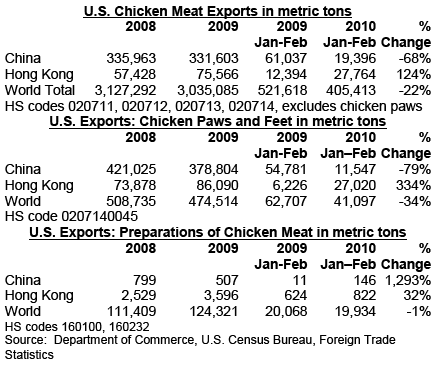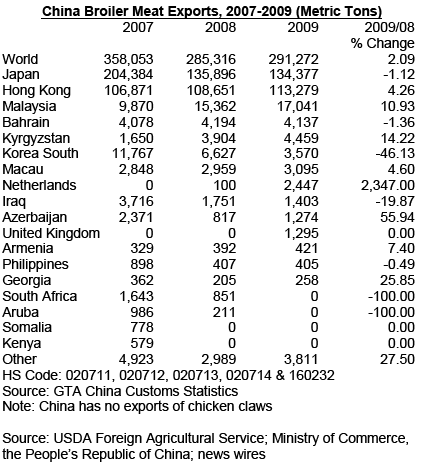



International Egg and Poultry Review: China
CHINA - This is a weekly report by the USDA's Agricultural Marketing Service (AMS), looking at international developments concerning the poultry industry. This week's report focuses on China's 'anti-subsidy' duty on US poultry on top of current anti-dumping duties.On 28 April 2010 China’s Ministry of Commerce (MOFCOM) announced it will levy anti-subsidy duties of up to 31.4 per cent on some chicken products from the United States that have received US government subsidies, starting 30 April 2010. This is on top of the anti-dumping duties China began collecting on 13 February 2010.
"The US government has provided subsidies to poultry farmers for forage crops like maize and soybeans which are used as feed for broiler chickens, which is raised specifically for meat production. This has not only given the US companies an unfair advantage in the Chinese market, but also hurt the interests of domestic companies," the ministry said in a statement. This is the first time that China has imposed duties on imports of agricultural goods on the grounds of alleged subsidies.
According to the ministry, US chicken exporters who had submitted information to the government investigation would face duties ranging from 3.8 per cent to 11.2 per cent, while the remaining companies would be subjected to higher tariffs. Chinese companies buying broiler-chicken products from the US will need to pay a deposit to the Customs authorities in line with the duty from Friday, 30 April 2010.
MOFCOM launched its anti-dumping and countervailing investigations of US broiler products on 13 September 2009; a separate investigation of US subsidies for broiler production was announced on September 27, 2009. On 5 February 2010 MOFCOM imposed preliminary import anti-dumping duties as high as 105.4 per cent on US chicken products and US chicken producers began paying cash deposits on 13 February 2010.
The anti-dumping duties range from 43.1 per cent to 80.5 per cent for the 35 companies that appealed the ruling. Other firms are charged 105.4 per cent. These cash deposits will be held until the final determination in the investigation, which is expected this summer. The anti-dumping investigation included products under the following tariff lines: 02071100, 02071200, 02071311, 02071319, 02071321, 020721329, 02071411, 02071419, 02071421, 02071422, 02071429, and 05040021 (frozen chicken gizzards).

China’s broiler production is expected grow almost 4 per cent to reach over 12.55 million metric tons (MMT) in 2010. This comes on top of a 2 per cent increase in 2009. Strong sales of breeding chickens in 2009 indicate strong production of commercial broilers in 2010. In 2009, imports of grand-parent generation western broiler stocks reached 112,320,000 birds, up 19 per cent from the previous year (94,308,000 birds).
Chinese broiler consumption is forecast to increase 4 per cent to 12.68 MMT in 2010 due to stronger economic growth and consumer demand. The absence of avian influenza outbreaks is supporting stronger consumption and the return of migrant workers to manufacturing jobs has been another factor. An estimated 20 million migrants became jobless in 2008/09 due to global recession. Reportedly, 90 per cent of these workers have since returned.

China’s poultry meat exports are expected to grow 3 per cent to 300,000 MT in 2010 due to recovering economies in Japan and Hong Kong, China’s two main markets. Chinese poultry exports to Malaysia, the EU and Kyrgyzstan have increased and China is expecting Canada to approve exports of cooked poultry later this year. The US has resumed its procedure for reviewing China’s market access request for cooked poultry exports to the US.

Further Reading
| - | You can view the full report by clicking here. |








